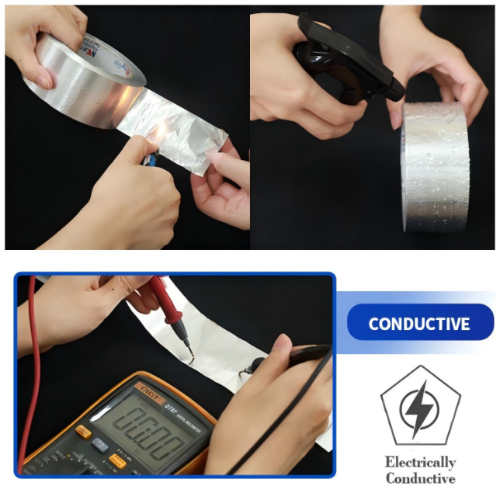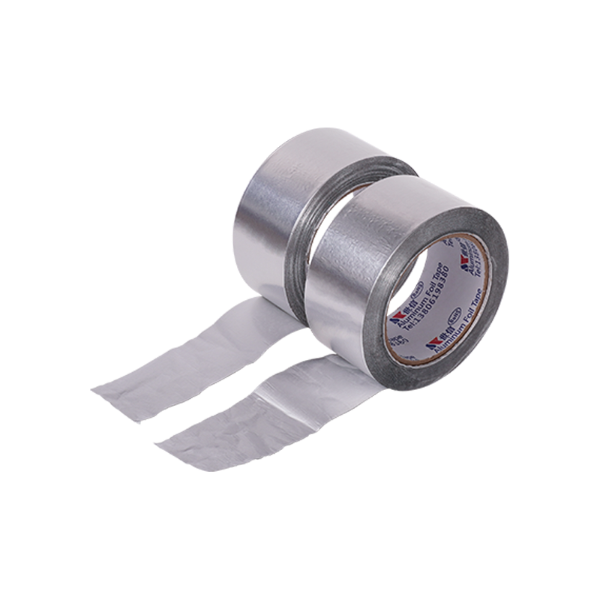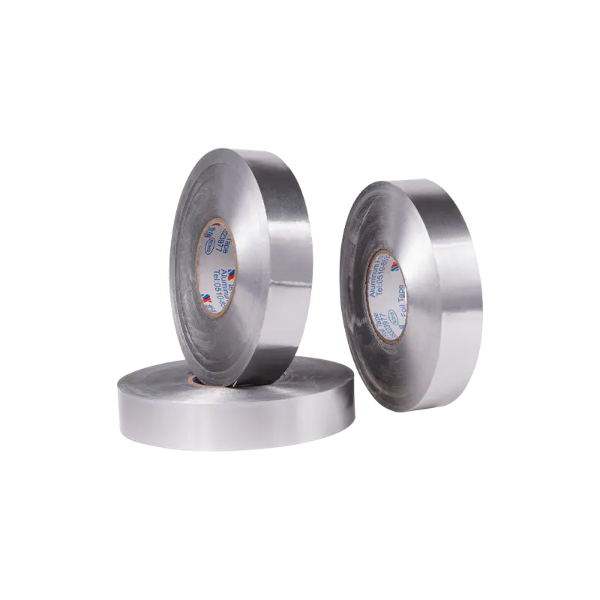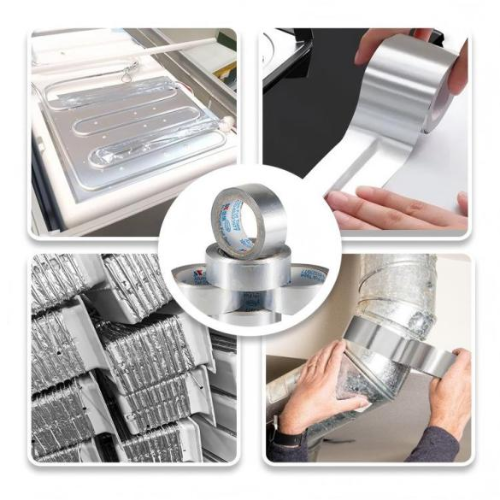
Traditionally, aluminum foil tape has been produced with a liner—usually a thin paper or plastic sheet that covers the adhesive until it is ready to be applied. While functional, this liner introduces inefficiencies: it must be peeled away during use, it adds waste, and it slows down application time. By contrast, linerless aluminum foil tape replaces the liner with a special release coating on the back of the foil, allowing it to be rolled and stored without sticking to itself.
But beyond these practical changes lies a deeper story: one that involves material science, environmental responsibility, and cross-industry applications ranging from HVAC systems to aerospace shielding. In this expanded technical guide, we will explore the full breadth of what makes pure aluminum foil tape without liner such a valuable tool.
The base of the tape is made from pure aluminum, typically with a purity of 99% or higher. This purity ensures:
· Corrosion resistance: The natural oxide layer protects against oxidation and chemical degradation.
· Thermal conductivity: With a thermal conductivity of ~235 W/m·K, it is ideal for heat transfer applications.
· Reflectivity: Reflects up to 97% of radiant energy, aiding in insulation.
· Mechanical stability: Balances flexibility with tensile strength for durable applications.
The adhesive is the heart of the tape’s performance. In pure aluminum foil tape without liner, the adhesive must not only bond securely to surfaces but also remain stable without the protective layer of a liner.

Common adhesive systems used:
|
Adhesive Type |
Key Properties |
Best For |
Limitations |
|
Acrylic |
UV resistant, long-term aging stability, excellent in extreme temperatures |
Outdoor applications, HVAC |
Slightly lower initial tack than rubber |
|
Rubber-based (natural or synthetic) |
Strong initial tack, bonds to low-energy surfaces |
Indoor quick repairs, packaging |
Poor UV resistance, limited high-temp performance |
|
Silicone |
Excellent high-temp stability (up to 500°F), chemical resistance |
Aerospace, industrial sealing |
Higher cost |
Special formulation considerations for linerless design:
· High cohesive strength to resist slumping or flowing under heat.
· Controlled surface energy to balance bond strength with peel resistance during unwinding.
· Additives for oxidation inhibition, UV stabilization, and flame resistance.
Instead of a removable liner, pure aluminum foil tape without liner uses a release coating on the foil’s back. This layer is typically made of:
· Silicone polymers for non-stick performance.
· Fluoropolymer blends for chemical resistance.
· Hybrid coatings combining silicone with inorganic fillers to improve abrasion resistance.
The coating must be ultra-thin (often less than 2 microns) to avoid altering the flexibility or weight of the tape, yet effective enough to prevent blocking (adhesive sticking to the foil back during storage).
|
Property |
Typical Value |
Functional Advantage |
|
Aluminum Purity |
99% or higher |
Ensures consistent conductivity and corrosion resistance |
|
Foil Thickness |
21μ--70μ |
Balances flexibility with durability |
|
Adhesive Temperature Range |
-40°F to +300°F |
Suitable for extreme environments |
|
Reflectivity |
95% – 97% |
Effective heat and light reflection |
|
Tensile Strength |
≥20n/cm |
Resists tearing and maintains integrity under tension |
|
Adhesive Type |
Acrylic / Rubber / Silicone |
Allows customization for specific applications |

Linerless foil tape speeds up duct sealing by eliminating the liner peel step. It maintains airtight seals under high-pressure airflow, prevents condensation, and improves energy efficiency.
Example: A commercial HVAC contractor reported a 20% reduction in installation time when switching to linerless tape on large-scale ductwork.
Used for thermal shielding, wire harness wrapping, and fuselage repairs. The light weight, high-temperature resistance, and flame-retardant options meet strict aerospace standards like FAR 25.853.
When wrapped around cables or enclosures, the conductive aluminum layer blocks electromagnetic interference, protecting sensitive electronics in data centers, medical devices, and military communication systems.
Saltwater corrosion resistance makes it suitable for sealing boat hatches, marine HVAC, and electronic enclosures.
Seals joints in reflective insulation, vapor barriers, and radiant heat systems, improving thermal performance and moisture protection.
|
Feature |
Linerless Tape |
Traditional Lined Tape |
|
Application Speed |
Very fast—no liner removal needed |
Slower—liner must be peeled before application |
|
Waste Generated |
Minimal—no liner to discard |
High—liner waste from every strip applied |
|
Ease of Use |
Simple, one-step application |
Two-step process, more cumbersome |
|
Environmental Impact |
Lower—less material waste |
Higher—liner waste contributes to landfill |
|
Storage and Handling |
Compact, no loose liners |
Liners can wrinkle, tear, or stick |

Case Study 1: HVAC Efficiency Upgrade in Texas
A large hospital retrofitting its HVAC systems switched from lined to pure aluminum foil tape without liner. Result:
· Installation time reduced by 18%.
· Waste reduced by over 500 lbs of liner material.
· Long-term seal performance maintained after 12 months.
Case Study 2: Aerospace Wire Harness Protection
An aerospace manufacturer used linerless silicone-based foil tape for high-temperature wiring bundles. The tape maintained adhesion at 450°F during jet engine ground tests, outperforming lined acrylic tapes.
Case Study 3: EMI Shielding in Data Centers
An IT facility wrapped server rack seams with linerless foil tape. Electromagnetic interference was reduced by 35%, meeting stringent compliance for sensitive medical data storage.
|
Problem |
Cause |
Solution |
|
Tape won’t stick to surface |
Surface contamination (oil, dust, moisture) |
Clean thoroughly with isopropyl alcohol |
|
Edges lifting over time |
Insufficient pressure during application |
Use roller/squeegee to ensure full contact |
|
Tape tearing during unwind |
Low-quality manufacturing or improper storage |
Store in cool, dry place; choose reputable brand |
|
Poor adhesion in cold weather |
Adhesive below activation temp |
Warm tape and surface before application |
· Waste Reduction: By eliminating liners, manufacturers and end users reduce landfill contributions.
· Recyclability: Pure aluminum foil is recyclable, though adhesive removal can be a challenge—R&D is underway on fully recyclable adhesive systems.
· Growing Demand: With industries under pressure to reduce carbon footprints, linerless tape aligns with green procurement policies.
· Technological Innovation: Future developments may include nano-engineered adhesives for even higher bond strength without increasing thickness.
Pure aluminum foil tape without liner is more than just a convenience—it’s a multi-industry solution that blends efficiency, performance, and sustainability. With the right adhesive chemistry, proper application, and understanding of its capabilities, it can outperform traditional lined tapes in speed, cost savings, and environmental impact.
Whether you are sealing HVAC ducts, shielding electronics, or patching aerospace components, linerless aluminum foil tape offers a high-performance, waste-reducing alternative that meets modern demands.